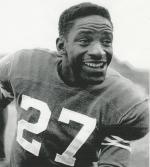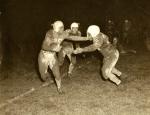![header=[Marker Text] body=[First African American to play quarterback in the modern National Football League and in the Big Ten Conference. He played in two games for the Chicago Bears in 1953 and was a member of Michigan State's national championship team in 1952. Thrower first played football here, for New Kensington High School's WPIAL champion teams, 1946-48. He finished his career in Canada at age 27. ] sign](http://explorepahistory.com/kora/files/1/10/1-A-311-139-ExplorePAHistory-a0k6f7-a_450.jpg)
Mouse over for marker text
Name:
Willie Thrower
Region:
Laurel Highlands/Southern Alleghenies
County:
Westmoreland
Marker Location:
Valley High School, 703 Stevenson Blvd., New Kensington
Dedication Date:
November 24, 2003
Behind the Marker
Could there ever been a more appropriate name for a quarterback than Willie Thrower? Could there have been a worse time for Willie Thrower to reach the NFL than in the early 1950s?
Although the NFL fielded black players in its first decade, the 1920s, team owners entered into a "Gentleman's Agreement" at the height of the Great Depression to bar black players, which they enforced until 1946, the year after World War II ended, and the year before the integration of Major League baseball. Few teams signed black players until the mid-1950s, and almost all who played were either running backs, receivers, defensive linemen, or defensive backs. In an era when quarterbacks called their own plays, the idea of an African-American field general was simply a non-starter. Blacks, went the thinking, were not smart enough to remember the complex playbook, nor could they entrusted to lead a team.
To be sure, all of that conspired against western Pennsylvania's Willie Thrower, who became the first black to stand over center in the NFL, playing one game for the Chicago Bears in 1953. Thrower's achievement earned no special attention at the time, but the fact remains, he blazed a trail. "I look at it like this," he said years later, "I was like the Jackie Robinson of football. A black quarterback was unheard of before I hit the pros."
Thrower would remain the game's only African-American quarterback until Marlin Briscoe piloted the Denver Broncos fifteen years later. Another two decades would pass before black quarterbacks like Doug Williams, Warren Moon, Randall Cunningham, and Steve McNair, and the Daunte Culpeppers, Michael Vicks and Donovan McNabbs who followed, would be accepted as exceptional players rather than unusual exceptions.
Born in 1930, Willie Lawrence Thrower grew up in the steel belt, twenty miles northeast of Pittsburgh, in New Kensington. With its immigrant stock and blue-collar communities, the region had latched onto football by the late 1800s, drawn in the sport's brawn, its toughness, and its grit–qualities these communities saw in themselves. High-school stars became heroes, and from the middle of the twentieth century on, western Pennsylvania became a crucible for manufacturing quarterbacks. George Blanda, Johnny Unitas, Joe Namath, Joe Montana, Jim Kelly, and Dan Marino, Hall of Famers all, were forged in the region and played their high-school ball within passing distance of one another. But none left a bigger imprint on the high school gridiron than Thrower.
Johnny Unitas, Joe Namath, Joe Montana, Jim Kelly, and Dan Marino, Hall of Famers all, were forged in the region and played their high-school ball within passing distance of one another. But none left a bigger imprint on the high school gridiron than Thrower.
A stellar athlete, Thrower made the varsity at New Kensington's Valley High as a freshman. His strong arm and quick feet were ideal for a halfback, the closest position to quarterback, in the team's single-wing offense, and Thrower's talents turned a strong squad into a championship one. Thousands filled the stands to thrill to his abilities, and under his leadership, Valley High won two western Pennsylvania titles and lost just a single game in his last three seasons. In his senior year, Thrower made all-state and was named an All-American.
Still, Thrower was black, and America was still segregated. Many college recruiters, awed by reports, turned away when they realized Thrower was not white. In 1947, the Orange Bowl actually rescinded the invitation it had extended to Valley High to play in the annual prep classic game when organizers saw a photograph of its star.
Michigan State, on the other hand, was far more enlightened. Coach Biggie Munn didn't care what color Thrower was, just that he was smart, he could play, and he could fit into the Spartan program. Traditionally, college coaches turned black quarterbacks into halfbacks or receivers. Remarkably, Munn converted Thrower into a quarterback. In 1950, Thrower's first season of varsity eligibility, he became the first black quarterback to play in a Big 10 game. Though never a starter, he was a regular contributor. Stepping in for injured All-American quarterback Tom Yewcic, Thrower led the Spartans to a crucial victory against Notre Dame en route to the 1952 National Championship. "He probably threw the ball as good as anyone in football," Yewcic remembered.
Almost a year to the day later, on October 18, 1953, he was sent into his first, and only, NFL game, taking over for the erratic George Blanda against the San Francisco 49ers in Chicago Soldiers Field. Though undrafted out of college, the Bears had signed Thrower for $8,500 as one of Blanda's back-ups. And although his one appearance resulted in just three completed passes in eight attempts for 27 yards, it resonated with the black quarterbacks who followed. "He only played in one game," stresses Hall of Famer Warren Moon, but "it was a game that has huge significance historically and psychologically."
Cut loose by the Bears before the next campaign, Thrower played in Canada until a separated shoulder ended his career in 1957. He became a social worker in New York, then moved back to New Kensington with his wife and children in the late 1960s, where he owned and operated a tavern. He liked to refer to himself as Willie the Pro.
The year before his death in 2002, ABC-TV aired a feature on Thrower as part of its Black History Month celebrations. Although his contribution had for the most part been overlooked, Thrower felt vindicated by the late recognition. "Now [people] say, ‘Gee whiz, here's a guy living in our hometown. We didn't know he was the first black quarterback," he said at the time. "Just like they didn't know, the rest of the country didn't know."
Finally, they did. A bronze statue honoring Thrower now stands at Valley High School.
Although the NFL fielded black players in its first decade, the 1920s, team owners entered into a "Gentleman's Agreement" at the height of the Great Depression to bar black players, which they enforced until 1946, the year after World War II ended, and the year before the integration of Major League baseball. Few teams signed black players until the mid-1950s, and almost all who played were either running backs, receivers, defensive linemen, or defensive backs. In an era when quarterbacks called their own plays, the idea of an African-American field general was simply a non-starter. Blacks, went the thinking, were not smart enough to remember the complex playbook, nor could they entrusted to lead a team.
To be sure, all of that conspired against western Pennsylvania's Willie Thrower, who became the first black to stand over center in the NFL, playing one game for the Chicago Bears in 1953. Thrower's achievement earned no special attention at the time, but the fact remains, he blazed a trail. "I look at it like this," he said years later, "I was like the Jackie Robinson of football. A black quarterback was unheard of before I hit the pros."
Thrower would remain the game's only African-American quarterback until Marlin Briscoe piloted the Denver Broncos fifteen years later. Another two decades would pass before black quarterbacks like Doug Williams, Warren Moon, Randall Cunningham, and Steve McNair, and the Daunte Culpeppers, Michael Vicks and Donovan McNabbs who followed, would be accepted as exceptional players rather than unusual exceptions.
Born in 1930, Willie Lawrence Thrower grew up in the steel belt, twenty miles northeast of Pittsburgh, in New Kensington. With its immigrant stock and blue-collar communities, the region had latched onto football by the late 1800s, drawn in the sport's brawn, its toughness, and its grit–qualities these communities saw in themselves. High-school stars became heroes, and from the middle of the twentieth century on, western Pennsylvania became a crucible for manufacturing quarterbacks. George Blanda,
A stellar athlete, Thrower made the varsity at New Kensington's Valley High as a freshman. His strong arm and quick feet were ideal for a halfback, the closest position to quarterback, in the team's single-wing offense, and Thrower's talents turned a strong squad into a championship one. Thousands filled the stands to thrill to his abilities, and under his leadership, Valley High won two western Pennsylvania titles and lost just a single game in his last three seasons. In his senior year, Thrower made all-state and was named an All-American.
Still, Thrower was black, and America was still segregated. Many college recruiters, awed by reports, turned away when they realized Thrower was not white. In 1947, the Orange Bowl actually rescinded the invitation it had extended to Valley High to play in the annual prep classic game when organizers saw a photograph of its star.
Michigan State, on the other hand, was far more enlightened. Coach Biggie Munn didn't care what color Thrower was, just that he was smart, he could play, and he could fit into the Spartan program. Traditionally, college coaches turned black quarterbacks into halfbacks or receivers. Remarkably, Munn converted Thrower into a quarterback. In 1950, Thrower's first season of varsity eligibility, he became the first black quarterback to play in a Big 10 game. Though never a starter, he was a regular contributor. Stepping in for injured All-American quarterback Tom Yewcic, Thrower led the Spartans to a crucial victory against Notre Dame en route to the 1952 National Championship. "He probably threw the ball as good as anyone in football," Yewcic remembered.
Almost a year to the day later, on October 18, 1953, he was sent into his first, and only, NFL game, taking over for the erratic George Blanda against the San Francisco 49ers in Chicago Soldiers Field. Though undrafted out of college, the Bears had signed Thrower for $8,500 as one of Blanda's back-ups. And although his one appearance resulted in just three completed passes in eight attempts for 27 yards, it resonated with the black quarterbacks who followed. "He only played in one game," stresses Hall of Famer Warren Moon, but "it was a game that has huge significance historically and psychologically."
Cut loose by the Bears before the next campaign, Thrower played in Canada until a separated shoulder ended his career in 1957. He became a social worker in New York, then moved back to New Kensington with his wife and children in the late 1960s, where he owned and operated a tavern. He liked to refer to himself as Willie the Pro.
The year before his death in 2002, ABC-TV aired a feature on Thrower as part of its Black History Month celebrations. Although his contribution had for the most part been overlooked, Thrower felt vindicated by the late recognition. "Now [people] say, ‘Gee whiz, here's a guy living in our hometown. We didn't know he was the first black quarterback," he said at the time. "Just like they didn't know, the rest of the country didn't know."
Finally, they did. A bronze statue honoring Thrower now stands at Valley High School.







